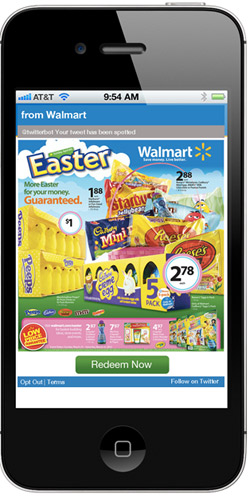Commentary
LocalResponse and ShopLocal Target Point-Of-Sale Intent With Pocket Circulars
- by Steve Smith , Staff Writer @popeyesm, July 20, 2012
 The mobile opportunity is no more stark and lucrative than at the point of sale, where consumers essentially bring the Internet into the store. In a novel use of its already
novel social media targeting system, LocalResponse will send mobile-optimized versions of store circulars to customers who have signaled their intent to be at the retailer. The effort is a partnership
with digital circular provider ShopLocal. “We’re using our intent data essentially to serve up a mobile circular,” says Kathy Leake, president and co-founder of LocalResponse.
The mobile opportunity is no more stark and lucrative than at the point of sale, where consumers essentially bring the Internet into the store. In a novel use of its already
novel social media targeting system, LocalResponse will send mobile-optimized versions of store circulars to customers who have signaled their intent to be at the retailer. The effort is a partnership
with digital circular provider ShopLocal. “We’re using our intent data essentially to serve up a mobile circular,” says Kathy Leake, president and co-founder of LocalResponse.
In all of its targeting campaigns, LocalResponse uses a range of different social signals to locate users with intent. There are the most obvious and explicit signals like actual check-ins that are made public by users across their mobile and online social nets. But then there are also the less explicit social signals. “We define ‘intent’ as someone who uses location-based services to check in or someone broadcasting their location,” Leake explains. “There is also another layer of what we call sentiment targeting. So they might be targeted because they mention publicly they are looking for back-to-school clothes.”
LocalResponse uses Twitter as the delivery mechanism, so by design the system tends to find and target some of the more socially savvy mobile users. The circular can be delivered in real-time, as the signal is seen or timed to go to the user on a timed basis after the signal.
LocalResponse is taking the ShopLocal SmartCircular product and optimizing the content for mobile delivery. Previously, SmartCircular was only available on desktop browsers. By mobilizing the content and delivering it in-store, the circulars can be customized to include incentives, coupons and special discounts. No partners have been announced at launch, but ShopLocal already works with Target, BestBuy, Home Depot, Staples and others.
LocalResponse rolled out its unique mobile targeting system about a year ago. The company analyzes via semantic natural-language processing up to 340 million pieces of data a day from Twitter, Instagram, foursquare, Yelp, and others to find people in specific locations giving off intent signals. Leake says they have about 75 clients and are on a run rate of $6 million in revenue this year. They have worked with H&M, Macy’s, and Audi.
The method of harvesting intent data from the public social media rapids may seem creepy to some. But in fact, it is both pulling content from people who are active in social media already and using the Twitter channel to target messaging and offers to them. I am also guessing that in many cases the social signals that led a marketer to tweet that user are probably identifiable by the user. My own sense is that if people are already broadcasting sentiments, locations, etc. via their social media channels (although some may not be aware how public they are), then these are users who are signaling a willingness to engage in conversations with people or brands.



